Crafting the Perfect Rustic Bath: Design Essentials
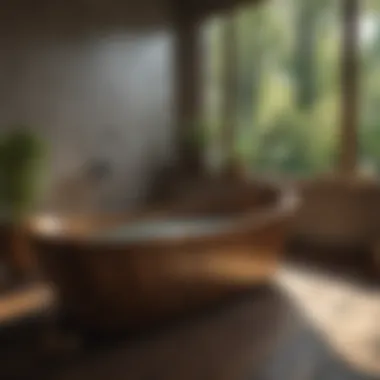
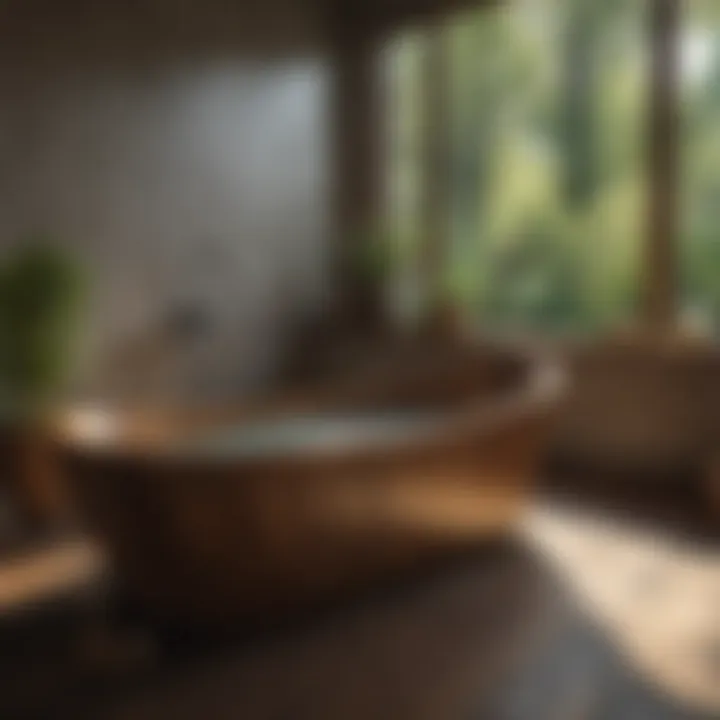
Intro
Creating a rustic bath is a rewarding endeavor that fuses practicality with a warm aesthetic. The rustic style invites a sense of tranquility and connection to nature, making the bathroom a sanctuary. This article will guide you through the essential elements that characterize a rustic bath while providing insightful strategies for blending comfort with function. From thoughtful design inspirations to important maintenance tips, each aspect will enhance the unique charm that defines this style.
Design Inspirations
Trending Styles
Rustic design can include various styles, each offering its own flavor. One popular route is the farmhouse style. It often incorporates vintage ornaments, wood beams, and open spaces. Another approach is the cabin-style, which tends to favor natural woods and stone elements. Combining these styles results in a distinctive aesthetic.
Key Elements:
- Reclaimed wood
- Stone accents
- Vintage fixtures
- Natural fabrics
These components establish a cozy atmosphere while ensuring a personal touch. Additionally, consider using locally sourced materials. This decision not only supports regional artisans but also adds character and authenticity to the space.
Color Palettes
Choosing the right color palette is crucial for a rustic bath. Earthy tones create a grounded feel. Shades like deep greens, warm browns, and soft grays work well together. Accentuate with light neutral colors to maintain balance.
"A well-thought-out color scheme can transform an ordinary space into an extraordinary one."
To create depth, think about layering colors. For example, a deep green can be paired with lighter wood tones. Other color combinations can include soft blue against rich browns. Always consider the existing light in the bathroom, as it influences how colors appear.
Maintenance and Upkeep
Seasonal Maintenance Checklist
A rustic bath needs regular upkeep to maintain its charm. Create a seasonal checklist to ensure it remains inviting:
- Spring: Check for leaks and mold due to humidity. Clean surfaces thoroughly and replace any worn linens.
- Summer: Inspect wooden fixtures for wear. Apply protective coatings if necessary.
- Autumn: Prepare for winter by sealing any gaps and checking for drafts.
- Winter: Maintain humidity levels and clear the bathroom of any debris.
Cleaning and Organization Tips
Maintaining a rustic bath requires careful attention to both cleaning and organization. Focus on using gentle, natural cleaning products. For example, vinegar and baking soda can clean surfaces without damaging materials.
Keep the space organized by utilizing natural storage solutions. Woven baskets, wooden shelves, and vintage cabinets work effectively. These not only provide storage but also enhance the rustic feel of the bath, making it more functional while keeping the aesthetics intact.
Understanding Rustic Design
The rustic style is characterized by its earthy textures and organic materials. Thus, identifying what makes a space "rustic" guides decision-making. By harnessing elements like wood and stone, homeowners can create an environment that emanates warmth and tranquility. Moreover, these materials blend well with ample greenery, enhancing the natural theme.
Defining Rustic Style
Defining rustic style goes beyond mere aesthetics; it encompasses a way of living that cherishes the natural world. Rustic design often features raw, unrefined materials that have not gone through extensive manufacturing processes. For example, reclaimed wood might be used for cabinets or flooring. This choice not only offers character but also contributes to sustainability.
There are several key characteristics that define rustic style:
- Natural Materials: Wood, stone, and natural fibers form the backbone of rustic design. These materials showcase a uniqueness that manufactured items cannot replicate.
- Earthy Color Palettes: The color scheme draws heavily from nature, favoring browns, greens, and muted tones. These hues create a calming atmosphere.
- Simple Furniture: Furniture is functional and often handmade, reflecting craftsmanship rather than mass production. Simplicity reigns over ornamentation.
- Textural Diversity: Rustic spaces often incorporate a range of textures, mixing smooth woods with rough stone or wool fabrics.
In summary, rustic design is rooted in the appreciation of natural beauty and practicality.
Historical Context
The historical context of rustic design reveals its evolution through various cultures and time periods. Originating in rural settings, this design style has roots in everyday life. It captures the essence of agricultural communities, where homes were built using locally sourced materials.
In the early 20th century, the Arts and Crafts movement emphasized the significance of handcrafted items. Craftsmen began incorporating natural elements into their work, creating a distinctive rustic appeal. This era valued simplicity and authenticity, forging a link to nature that many modern designs lack.
Today, rustic design has embraced technological advancements while still honoring its history. It appeals to many who seek to escape the urban bustle. Many interior design enthusiasts are finding solace in this style, making it relevant again. Understanding this context aids in appreciating how rustic design has adapted over time while keeping its core principles intact.
The rustic design is not just a style; it is an embodiment of values that prioritize sustainability, craftsmanship, and a connection to nature.
By recognizing these fundamental aspects of rustic design, one can more effectively craft a space that embodies both aesthetics and practicality. This insight paves the way for selecting key elements that contribute to the overall charm of a rustic bath.
Key Elements of a Rustic Bath
The concept of creating a rustic bath greatly relies on specific elements that lend authenticity and warmth to the space. Each of these elements contributes to the overall aesthetic and functional purpose of the bath. Understanding and implementing these elements ensures a harmonious blend of charm and usability.
Natural Materials
Natural materials are essential in establishing the rustic ambiance. They evoke a sense of connection to nature and enhance the tactile experience of the bathroom.
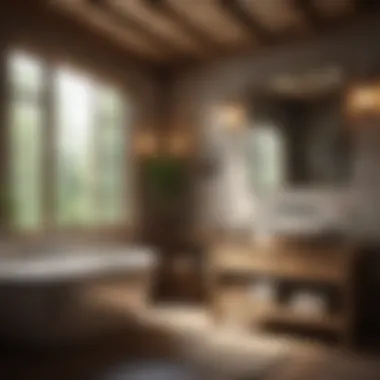
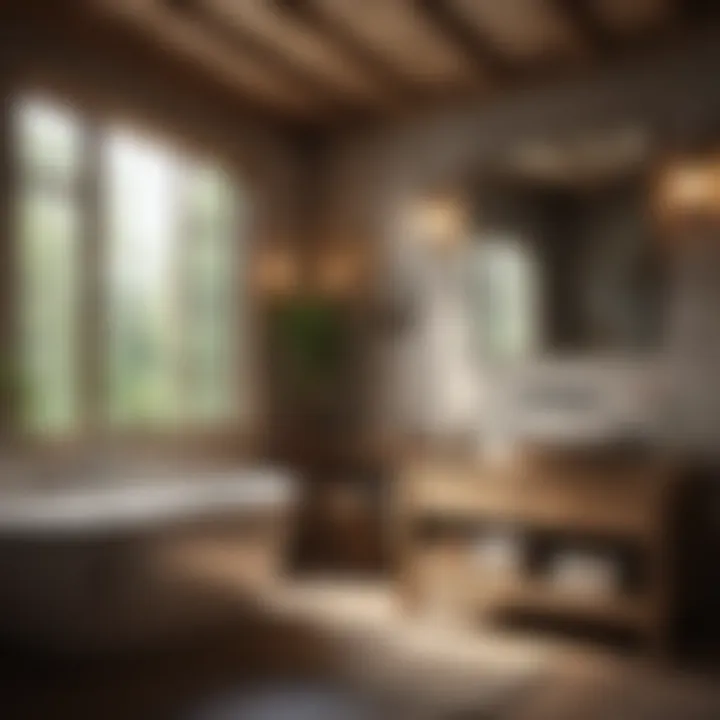
Wood
Wood is a predominant choice in rustic design. Its characteristic warmth brings an inviting quality to the space. The natural grains and knots of wood add unique visual interest. Common options include reclaimed barn wood, which not only provides beauty but also a sense of history.
However, wood requires careful treatment to withstand moisture. Using specialized coatings can help maintain its integrity. Despite this, the timeless appeal of wood makes it a popular choice.
Stone
Stone also plays a vital role in rustic baths. Its durability and unique textures enhance the natural feel of the space. Options like slate or limestone can create stunning floors or wall features.
The characteristic strength of stone ensures longevity with minimal maintenance. While it can be cold to the touch in cooler climates, incorporating radiant heating can solve this issue. The earthy presence of stone firmly anchors the rustic aesthetic.
Clay
Clay, typically in the form of terracotta tiles, introduces earthy warmth and a rustic palette. It can be used for flooring or decorative elements. The unique textural quality of clay tiles contributes to the overall sensory experience.
However, clay can be somewhat porous, requiring sealing to prevent stains or moisture issues. Its reflective quality adds dimension and enhances the charm of the rustic bath.
Color Palettes
The color palette chosen is pivotal for developing the rustic environment. By selecting the right colors, homeowners can create a cohesive atmosphere that matches their style.
Earthy Tones
Earthy tones, such as browns, greens, and muted yellows, establish an organic feel in the bath. These colors draw upon the natural world, resulting in a harmonious environment. Furthermore, they are easy to pair with natural materials used in rustic design.
These tones can foster a calming effect, essential for a bath space where relaxation is key. Their versatility allows for expansive combinations while ensuring a grounded aesthetic.
Muted Shades
Muted shades, including soft blues and greys, complement earthy tones effectively. They serve as tranquil accents that create a serene backdrop. These colors provide a sophisticated touch, preventing the space from feeling overly rustic or dated.
Their gentle influence encourages a peaceful ambiance, aligning perfectly with the restorative aspect of a bath. Owners can use these shades to balance the warmth of natural materials.
Accent Colors
Accent colors allow for personal expression within the rustic framework. Bold hues like deep reds or vibrant oranges can inject energy into the space. These colors act as a focal point and can draw attention to specific features, such as fixtures or artwork.
Yet, they must be used judiciously. Overwhelming the color scheme with bright accents can disrupt the calmness intended in a rustic design.
Textural Variety
Textural variety is another key element in crafting a rustic bath. Different textures create a more engaging and dynamic look that appeals to the senses.
Fabrics
In a rustic bath, fabrics play a significant role in softening the overall atmosphere. Using natural fibers—such as linen or cotton—for towels and curtains adds warmth.
The comfortable quality of these materials invites users to engage with the space. Soft, heavily textured fabrics can enhance the rustic feel while providing functionality.
Finishes
Finishes on surfaces—like cabinetry or walls—affect how the entire room feels. A distressed finish or a matte texture can emphasize the rustic character. It offers visual interest while maintaining simplicity.
Using finishes that highlight the material's natural beauty helps in achieving the desired rustic look. However, finishes need to be chosen carefully to balance durability with aesthetics.
Accessories
Accessories are the finishing touches that bring character to the rustic bath. Items such as handmade soap dishes, vintage mirrors, or artisan-crafted elements enhance the space.
These unique features highlight personal style and create focal points. While selecting accessories, it is important to ensure they align with the rustic theme. A mismatch can detract from the overall design, so thoughtful choices matter.
Integrating these key elements into a rustic bath creates a cohesive environment that combines functionality and beauty. By focusing on natural materials, color palettes, and textural variety, homeowners can transform their spaces into serene retreats.
Designing Functional Spaces
Designing functional spaces is crucial in crafting a rustic bath that is both practical and visually appealing. The bathroom is not just a place for hygiene, but also a personal sanctuary where comfort and style should coexist. Therefore, understanding how to maximize space, ensure flow and accessibility, and integrate effective storage solutions is imperative. When these aspects come together harmoniously, they enhance the overall experience of the space.
Layout Considerations
Maximizing Space
Maximizing space is essential, particularly in smaller bathrooms typical of rustic design. The key characteristic of maximizing space lies in clever design choices that create a feeling of openness. Multi-functional furniture and compact fixtures can contribute significantly to this goal. An example of a popular choice is wall-mounted sinks and toilets, which not only free up floor space but also provide a clean visual line.
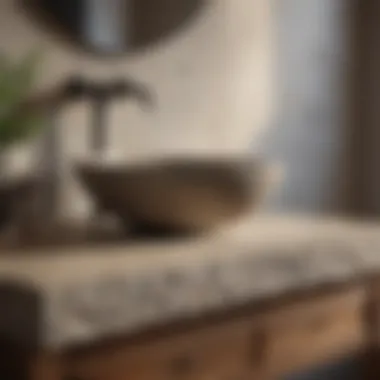
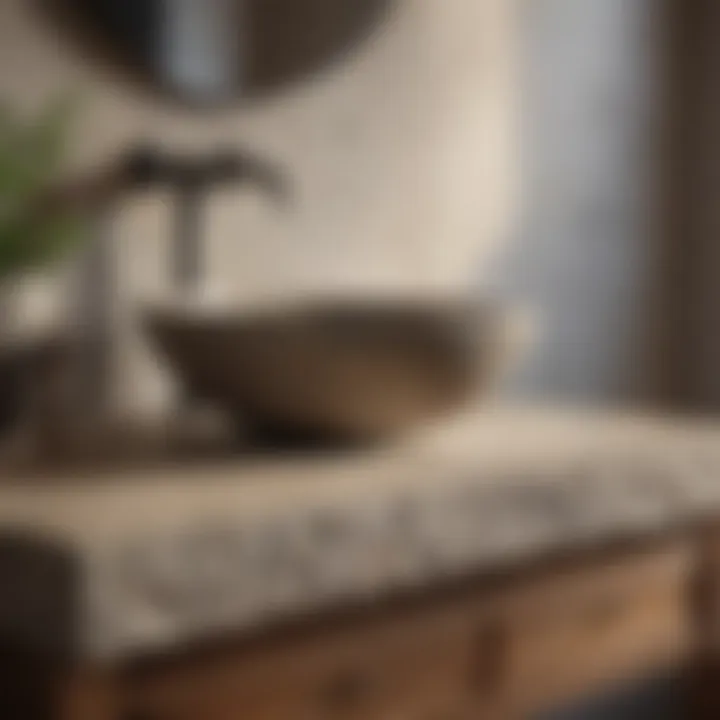
However, the unique feature of maximizing space is its flexibility. Furniture can be selected to fit the specific dimensions of a bathroom, thereby ensuring every square foot is used effectively. While these solutions can significantly enhance usability, it is important to consider potential drawbacks, such as limited storage capacity that might necessitate additional solutions.
Flow and Accessibility
Flow and accessibility are vital components in any functional bath design. A key aspect here is the practical arrangement of fixtures and furniture, allowing smooth movement within the space. This characteristic promotes relaxation by enabling efficient use of the bathroom.
Flow and accessibility are beneficial because they ensure that each element of the bath serves its purpose without hindrance. For instance, positioning the bathtub near the shower can save time and space. The unique advantage of addressing flow and accessibility is the improved comfort it provides, but a disadvantage may arise when trying to fit oversized fixtures into a compact layout, which can disrupt the visual harmony intended by rustic design.
Storage Solutions
Open Shelving
Open shelving is a popular storage choice in rustic baths. It encourages a clutter-free environment by keeping essentials visible and easily accessible. The characteristic of open shelving is its simplicity and the opportunity it offers to showcase beautiful containers or textiles.
Incorporating open shelving contributes by allowing homeowners to personalize their space. By displaying natural materials such as wood and wicker, it enhances the rustic aesthetic. However, the downside to open shelving is the potential for everyday items to accumulate dust, which may necessitate regular cleaning.
Built-in Furniture
Built-in furniture presents a unique solution for maximizing space in a rustic bath. This option can provide a seamless look while also offering tailored storage solutions. The key characteristic of built-in furniture is its customizability, ensuring it fits perfectly within the designated area.
This contributes significantly to the overall goal of crafting a functional rustic bath. Its unique feature is that it enhances the usability of niches and corners that standard furniture cannot occupy. While built-in solutions can provide a streamlined aesthetic, they often require a larger upfront investment, which might be a consideration for some homeowners.
Lighting Choices
Natural Light
Natural light plays a crucial role in creating a welcoming rustic bath. The use of windows and skylights enhances the space, allowing sunlight to illuminate natural materials within the room. The key benefit of incorporating natural light is the positive atmosphere it can create, impacting mood and wellbeing.
Natural light also allows for the display of the rustic design's texture and color. However, one disadvantage is that it may lead to overheating or fading of materials if direct sunlight is too intense, but strategic placement of window treatments can help manage these concerns, maintaining comfort throughout the day.
Ambient vs. Task Lighting
Both ambient and task lighting are indispensable in any rustic bath design. Ambient lighting provides overall illumination, while task lighting targets specific areas for activities such as shaving or makeup application. The key characteristic of this dual approach is its versatility in ensuring each functional area is well-lit without overwhelming the senses.
In this article, the balance between ambient and task lighting contributes to the overall aesthetics and functionality. A unique feature is that different light fixtures—such as hanging lights or sconces—can enhance the rustic charm while serving their purpose. However, care must be taken to avoid a cluttered appearance by selecting fixtures that harmonize with the overall design scheme.
Incorporating Rustic Accessories
In the realm of rustic bath design, the integration of accessories plays a pivotal role in enhancing both aesthetic appeal and functionality. Accessories are not merely decorative; they serve as the finishing touches that can elevate the ambiance of the space. When thoughtfully chosen, rustic accessories complement the natural materials and design principles that define rustic style. This section will explore how to select the right fixtures, artwork, and textiles that not only adhere to rustic aesthetics but also improve the usability and comfort of the bathroom.
Choosing Fixtures and Fittings
Faucets
When selecting faucets for a rustic bath, the material and style are paramount. Brass and aged iron are two popular choices, reflecting the raw and unrefined aspects of rustic design. These materials are not just durable; they also bring character. The aged look of these faucets can create a sense of history, connecting to the rustic ethos. The unique feature of many rustic faucets is their ability to patina over time, which can enhance their charm.
Handles and Knobs
The choice of handles and knobs can dramatically affect the overall feel of your rustic bath. Opting for wooden or wrought iron handles can lend a handcrafted touch. These elements can often be found in vintage markets, allowing for customization that fits your style. A key characteristic is their tactile quality, which adds warmth to the design. The downside is that these materials might require more maintenance compared to typical handles, but their beauty can often justify the effort.
Artwork and Decor
Framed Prints
Framed prints can bring life to the walls of a rustic bath. They serve as visual focal points that can echo the surrounding nature through landscapes or botanical themes. The earthy colors in these prints can seamlessly tie the decor together, maintaining the rustic aesthetic. A significant benefit is their versatility; framed prints can be sourced from local artists or reproduced using archival methods, thus catering to different budgets and tastes.
Wall Hangings
Wall hangings, such as macramé or fabric art, can contribute texture and depth to the space. These pieces are not only decorative but can also impart a sense of coziness. A characteristic of wall hangings is their ability to soften the overall look. However, care must be taken to choose textiles that are suitable for high-moisture areas, as some materials may not hold up as well.
Textiles and Towels
Rugs
Rugs can significantly enhance the comfort of a rustic bath. A well-placed rug adds warmth underfoot and can delineate space. Selecting a natural fiber rug, such as jute or wool, aligns perfectly with the rustic theme. The key characteristic to look for is durability; rugs should be able to stand up to moisture and foot traffic. A potential disadvantage is that cleaning these rugs may require special care, but the benefits usually outweigh the cons.
Shower Curtains
Shower curtains are another essential textile in a rustic bath. Opting for a linen or canvas curtain can create a breezy effect that complements the overall design. Their practicality cannot be overstated, as they offer privacy while keeping moisture contained. The unique feature of rustic shower curtains is the variety of patterns available, from floral to geometric, which can align with your aesthetic goals. The disadvantage may be their tendency to accumulate mold if not properly maintained, making regular washing essential.
Sustainability in Rustic Design
Sustainability plays an essential role in the evolving theme of rustic design. By integrating eco-friendly principles, homeowners can create a bathroom that not only embodies natural beauty but also respects the environment. This section will discuss specific materials and methods that enhance sustainability in rustic baths. The benefits of these choices are twofold: they minimize the ecological footprint while ensuring a space that aligns with the aesthetics many seek in rustic design.
Eco-Friendly Materials
Reclaimed Wood
Reclaimed wood is a remarkable choice for sustainability in rustic bath designs. This material is sourced from old structures, like barns or warehouses, and repurposed for new uses. The primary characteristic of reclaimed wood is its rich history and unique surface textures that give it a distinct allure. It is beneficial because it reduces the need for new lumber, thus preserving forests and minimizing waste.
A unique feature of reclaimed wood is its ability to tell a story. Each piece carries its own past, often reflecting time's wear and tear, which adds character to any space. However, it is vital to consider that reclaimed wood requires proper treatment to prevent issues like pests or harmful bacteria, which may be a disadvantage in a moist environment like a bathroom.
Sustainable Textiles
Sustainable textiles are an additional key element in creating an eco-friendly rustic bath. These textiles are made from organic materials or recycled fibers, reducing pollution and waste in the manufacturing process. The primary characteristic that makes sustainable textiles popular is their minimal impact on the environment, as they often avoid harmful chemicals and dyes.
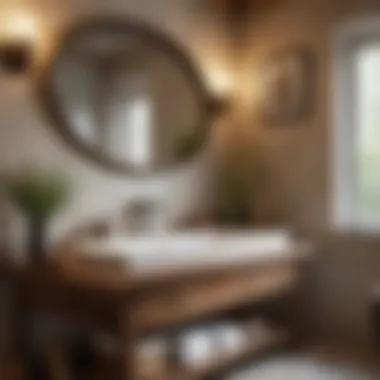
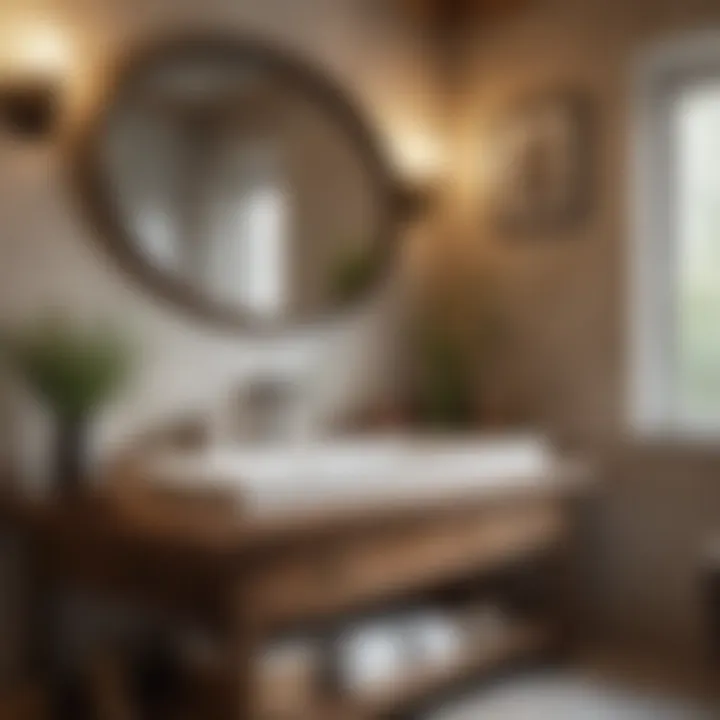
A unique feature of these textiles lies in their durability. They tend to withstand the test of time better than conventional fabrics. However, it is crucial to recognize that some sustainable options may have a higher upfront cost, which could be seen as a disadvantage when budgeting for a renovation.
Water Conservation
Low-Flow Fixtures
Low-flow fixtures contribute significantly to water conservation in rustic baths. These fixtures, including faucets and showerheads, limit water flow without sacrificing performance. The main characteristic of low-flow fixtures is their ability to reduce water usage by up to 60%. This makes them a highly beneficial choice for eco-conscious homeowners.
A unique feature of low-flow fixtures is their design versatility, as many options are available that fit perfectly within rustic aesthetics. However, some users might find that certain low-flow versions do not provide the same pressure as traditional fixtures, which can be viewed as a disadvantage.
Rainwater Harvesting
Rainwater harvesting is a sustainable practice that involves collecting and storing rainwater for bathroom use. This system integrates seamlessly into rustic designs since it often uses visible pipes and tanks, further enhancing organic aesthetics. The main characteristic of rainwater harvesting is its efficiency in utilizing natural resources, thus reducing dependency on municipal water systems.
A unique feature is that harvested rainwater can be used for flushing toilets or watering plants, which means versatility in its applications. Nonetheless, it may require significant upfront investment and space for tanks, which some homeowners may find challenging.
"Utilizing sustainable methods not only enhances the rustic appeal of your bath but also contributes positively to the planet's health."
In summary, incorporating sustainability into rustic design results in a bathroom that balances environmental respect with aesthetic beauty. The materials and conservation methods discussed in this section provide valuable insights for those looking to create an eco-friendly rustic space.
Case Studies and Inspirations
Incorporating case studies and inspirations is vital when discussing rustic bath design. These examples provide tangible illustrations of how the theory translates into real-world application. Studying successful designs helps homeowners and enthusiasts visualize possibilities. They can understand what works effectively within a rustic framework. Furthermore, observing various approaches allows for creativity to flourish while respecting rustic principles.
Successful Rustic Bath Designs
Residential Examples
Residential rustic bath designs often emphasize comfort and charm. One of the standout aspects of such designs is the use of reclaimed materials like vintage wood and stone. These elements contribute to warmth, making the space inviting. A classic feature is the freestanding tub, which adds a touch of luxury while maintaining a rustic feel. This combination is beneficial as it combines aesthetics with functionality.
The unique feature of these residential examples is their ability to provide a sense of retreat within the home. Many designs utilize earthy color palettes, such as deep browns and soft grays. This choice enhances the calming atmosphere of the bath. However, one potential drawback might be the maintenance involved with natural materials, as they can require more care than synthetic alternatives.
Commercial Spaces
In commercial environments, rustic bath designs can be both practical and stylish. A primary characteristic is their focus on durability; materials must withstand higher traffic. Rustic elements such as barn doors or industrial light fixtures are often used. These give an inviting vibe, which is essential for spas or boutique hotels. This approach helps brands create a memorable experience for guests.
A unique feature of commercial rustic baths is the blend of modern and traditional elements. Many spaces have integrated smart technology while keeping a rustic aesthetic. This balance can appeal to a broader audience, enhancing client satisfaction. However, there might be limits regarding extreme rusticity, as not all guests appreciate a fully rustic experience.
DIY Projects
Budget-Friendly Renovations
Budget-friendly renovations are a key aspect of crafting a rustic bath. They allow enthusiasts to embrace the rustic charm without significant financial burden. One common approach includes refinishing existing materials rather than replacing them. This technique not only saves money but also retains character in a space. Adding personal touches enhances both the aesthetic and emotional value of the home.
The key characteristic of budget-friendly renovations is resourcefulness. Homeowners often utilize second-hand finds or DIY projects to build their rustic sanctuary. One unique feature is the ability to transform inexpensive materials, such as pallets into storage solutions or decor. An advantage of this method is the personal satisfaction of creating something unique. However, it may require more time and effort than purchasing ready-made items.
Upcycling Ideas
Upcycling ideas are increasingly popular in the rustic decor realm. This approach involves repurposing old materials into functional and decorative pieces. The concept aligns perfectly with the principles of sustainability while reinforcing rustic aesthetics. For example, an old ladder could become a stylish towel rack. This transformation retains history while providing functionality.
A significant characteristic of upcycling is creativity with a purpose. By thinking outside the box, homeowners can create striking elements that tell a story. The unique feature is the opportunity to incorporate meaningful items into the design. For instance, a piece of reclaimed wood from a family cabin can hold special significance. The downside may be the skill required, as not everyone is comfortable with DIY projects.
Challenges and Solutions
Creating a rustic bath comes with its set of challenges. Understanding these challenges and finding solutions is essential for achieving a space that is both functional and aesthetically pleasing. Homeowners often face limitations such as space constraints, conflicting modern needs, and the desire to maintain a rustic aesthetic. Recognizing these hurdles allows for smarter design choices that complement the rustic style while ensuring usability.
Dealing with Limited Space
Space constraints are a common issue in many homes. Compact Solutions focus on maximizing every inch, an approach vital for small bathrooms. Merging functionality with style, compact solutions often feature multi-functional furniture and storage that blend seamlessly into their surroundings.
A key characteristic of compact solutions is their smart design. They incorporate features such as wall-mounted sinks and foldable furniture, which enhances the room's usability without sacrificing rustic charm. For instance, a wall-mounted sink can save floor space while contributing a touch of rustic elegance, particularly in materials like reclaimed wood or wrought iron. However, a disadvantage might be limited surface area for personal items, which requires clever organization.
On the other hand, Vertical Design utilizes the vertical space in a room effectively. This strategy emphasizes taller cabinets, shelves, and even vertical storage solutions. In rustic design, verticality can be utilized effectively by showcasing natural materials that draw the eye upward, creating a sense of height and spaciousness. It is common to see tall storage units that not only fit within style but also serve to maximize storage capabilities.
The unique feature of vertical design is its ability to increase storage without overtaking floor space. This aspect is significant in creating clutter-free environments, which is a must in rustic bathrooms where natural beauty is preferred over visual noise. However, installing tall fixtures can sometimes overwhelm smaller spaces if not executed thoughtfully.
Maintaining Rustic Integrity
Maintaining rustic integrity while addressing modern needs can feel delicate. Balancing Modern Needs involves incorporating elements that support contemporary life, such as technology or efficiency, without losing the authentic rustic touch. A beneficial choice in this regard could include selecting modern fixtures that mimic rustic styles, such as polished concrete sinks that have a clean and minimalist appearance.
The unique feature of balancing modern needs lies in its ability to appeal to a wider audience. By integrating modern conveniences — such as underfloor heating or energy-efficient lighting — a rustic bath can feel comfortable and user-friendly. However, an excess of modernity may disrupt the authentic rustic feel if not integrated with care.
Lastly, Staying True to the Aesthetic is paramount. This means selecting décor and furnishings that reflect the rustic aesthetic genuinely. For example, choosing natural wood furniture or stone finishing for counters can maintain the rustic vibe. The challenge here is ensuring that all elements feel cohesive without feeling forced.
The advantage of staying true to the aesthetic is that it invites warmth and character into the space. Guests can instantly feel the personality of the room. However, a potential disadvantage is that it may sometimes limit available choices or styles, which can be challenging for those seeking a more modern look.
"In rustic design, every decision must align with the desire for authenticity. The beauty lies in its simplicity and connection to nature."
By understanding these challenges and solutions, homeowners can create rustic baths that serve not only as functional spaces but also as cozy escapes, reflecting personal style and practicality.





